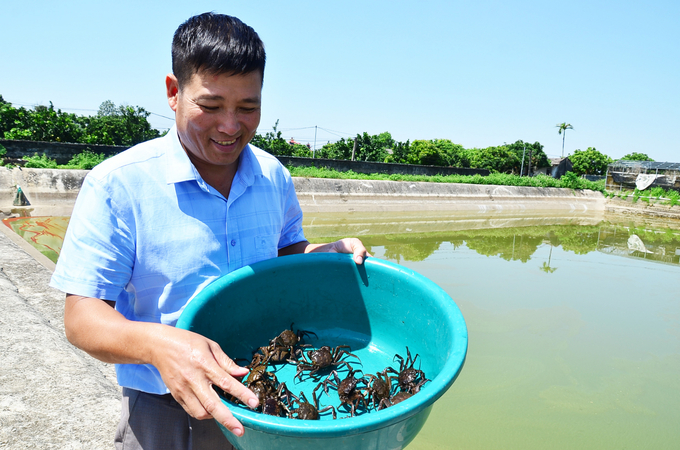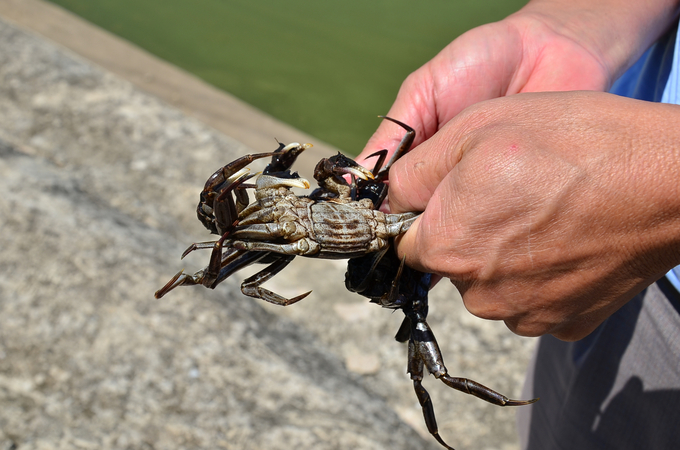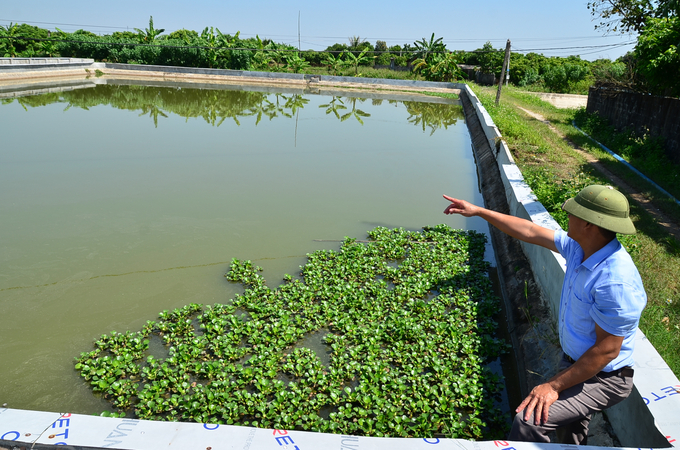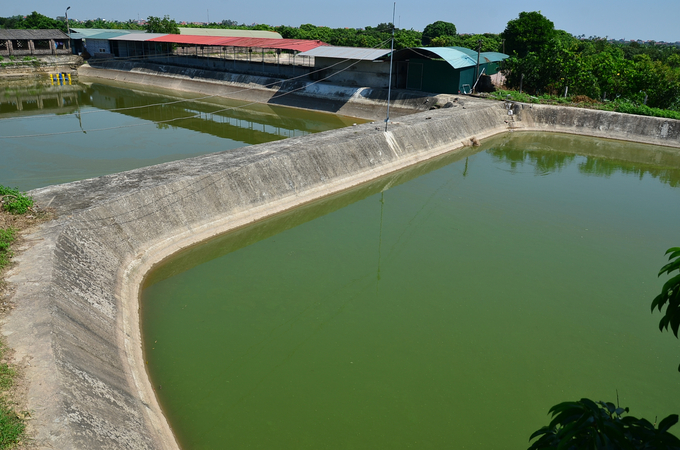May 29, 2025 | 15:41 GMT +7
May 29, 2025 | 15:41 GMT +7
Hotline: 0913.378.918
May 29, 2025 | 15:41 GMT +7
Hotline: 0913.378.918

Luu Van Dung with the young hairy crabs. Photo: Duong Dinh Tuong.
Luu Van Dung from Tho Lao village (Quang Hung commune, Phu Cu district, Hung Yen province) help up some slim-shaped hairy crabs with head and claw spewing out a soft and velvety bunch of fluff, then showed me how to distinguish the male and female crabs. “You see this, the one with the big abdomen is the female, and the one with the small abdomen is the male. They are growing very fast. Come back here next month, and we will have a hot pot. The female crabs would have had roe at that time, reaching a weight of 6-7 crabs/kg and priced at VND 700,000/kg. As for the male crabs, a pack of 6-7 crabs/kg has a price of VND 320,000/kg.”
When Dung saw people in the area focusing on managing ponds to release fish, another thought crossed his mind: “Why not turn the low-lying fields that led to precarious rice crops into a pond?” So in 2004 he started a contract with the commune to lease 2.4 ha of land to make that idea a reality. One step at a time, Dung gradually accumulated the land by buying or gathering the neighboring fields, at first it cost him VND 15 million per sao (1 sao equals 360 m2), and after a while it was VND 50 million, but he was still able to gather another 6 ha.

Close-up shot of a female hairy crab. Photo: Duong Dinh Tuong.
Dung said, “If you grow fruit trees, it takes 5-7 years to make a profit, while aquaculture only needs 5-7 months to have a profit. When I raised commercial fish in the past, I found it difficult to buy seeds, so difficult that sometimes I even had to wait all day and night at the production facility, so since 2006 I bred the seeds myself, most of which are common varieties such as grass carp, tilapia, African sharptooth catfish, barb, and rohu. After that, I bred some specialty-quality varieties such as climbing perch, broadhead catfish, black devil catfish, black carp, and hairy crab.
“My biggest failure was in 2010 when I raised 200,000 black devil catfish and suffered 60% loss of output due to disease. Plus the low selling price, I lost VND 600-700 million in that case. It was all my fault. I was too ‘hyped’ and took the risk while having no knowledge of the techniques. After that fall, I went to study aquaculture facilities in many provinces, then studied for 2 years at the Research Institute of Aquaculture I. I was finally able to say that I mastered the method to treat water sources, create oxygen, prevent and control diseases. The loss rate was soon reduced to only 5-7%, and each crop I could produce and sell 80-100 tons to the market.

A corner of Dung's large farm. Photo: Duong Dinh Tuong.
“In 2021, seeing that hairy crabs were always sold out when released to the market, I bought a bunch of seeds with each one as small as the cap of a beer bottle from some farmers in Quang Yen town, Quang Ninh province for VND 6,000/head. I brought back more than 10,000 seeds, but in the end, only nearly 3,000 were left. Most of them died because they were moved from brackish water to fresh water, which was a different environment. I still got more than 200 kg of hairy crabs that crop, sold for over VND 100 million, and thus made a little profit.
“Learning from this experience, in this crop I buy 30,000 seeds near Thai Binh river. At first they are 100 crabs/kg, now they grow into 20 crabs/kg. The crabs must be collected before November because it would very difficult to do it in winter. The food of hairy crabs is mainly minced fish of all types, and the rest is approximately 40% bran. They are voracious but like to eat clean. The fish must be fresh or they will not even touch the food. In order to avoid the crabs eating each other, the breeds must be uniform in size.
“To be fair, hairy crabs have very good resistance. They died in the first crop because of strange water, but that’s just a part of the reason. All the loss was due to them crawling on the concrete pond bank and over the fence 1.5m higher to get out. Some farmers outside fishing in the ditch even caught my crabs. Out there, they also dig burrows to live like normal crabs. So the next season, I smooth the pond edge, pave a layer of marble bricks, and then cover it with another layer of corrugated steel to prevent crabs from escaping.”

Dung's hairy crab pond. Photo: Duong Dinh Tuong.
If field crabs molt 4 times a year, hairy crabs only molt 3 times, and after each time they will grow very quickly. The shell already has a glossy black tone when they reach 1 year old. Dung estimates that this crop’s output is 600 – 700 kg, all have been ordered by buyers.
To be honest, natural hairy crabs still have a harder shell and sweeter flesh than farmed crabs, but because they are so rare, Dung’s crab sales still go well. His plan for next year is to research how to breed hairy crabs by supplementing them with calcium-rich food to help their shells become harder and shed quickly. He will also study more about the technique to keep hairy crabs warm through the winter by lighting lamps and using tarpaulins as a cover.
Dung bred the V1 hybrid carp in 2015, in 2017 he bred some spiny eels, and in 2019 it was the black carp’s turn. Every year his farm sells both fingerlings and fish for meat, making an average revenue of VND 12-13 billion with the profit accounting for 10-15%.
Possessing many bold ideas, not only he intends to breed hairy crabs, Dung also plans to domesticate cold water fish (sturgeon) in his hometown in the near future by drilling deep into the ground to find a source of cool water and then pumping it into the pond. If the temperature becomes too high, he would raise the fish in air-conditioned rooms.
Dung is currently the Director of Hung Phat Fisheries Cooperative with 24 members and a total breeding area of 50 ha. “Establishing a cooperative has the benefits that the seed source is guaranteed, inputs and feed can be purchased in large quantity while being given enjoy preferential incentives. But the common difficulties at present include poor electricity lines, bad traffic, and canals for aquaculture still have to share with rice cultivation. if I pump out, the rice will be flooded and the people will complain, but if I do not pump, the pond will overflow, and I might lose everything.”
The “Excellent Farmer of Vietnam” in 2020, the “Digital Transformation Farmer” in 2021 still wishes to expand the area further, however, "It's very difficult! People leave the land to waste but still refused to sell it or rent it out. They had this mentality of waiting for the State's compensation policy in the future.”
Translated by Samuel Pham
/2025/05/25/4127-3-073637_820.jpg)
(VAN) Thanks to the promotion from an FAO-implemented project, vegetable production in greenhouses in Moc Chau has seen strong development, from 1.5 hectares in 2021 to nearly 50 hectares in 2024.

(VAN) FAO has recently supported USD 140,000 to implement the project 'Risk mitigation human-animal interface risks through disease control initiatives in pig farming.'

(VAN) The People's Committee of Tra Vinh province has approved an adjustment to the investment policy for the Green Hydrogen Plant project, increasing its area to approximately 52.76 hectares.
![Reducing emissions from rice fields: [2] Farmers’ commitment to the soil](https://t.ex-cdn.com/nongnghiepmoitruong.vn/608w/files/news/2025/05/05/dsc08881jpg-nongnghiep-140632.jpg)
(VAN) Clean rice cultivation model in Thuong Tan commune, Bac Tan Uyen district, is assisting local residents in achieving sustainable agriculture by substantially reducing costs, increasing productivity, and protecting the environment.

(VAN) At the conference to disseminate Resolution No. 68, AgriS introduced its digital agricultural ecosystem and reaffirmed its commitment to accompanying the Government in promoting private sector development and sustainable agriculture.

(VAN) 'Blue Ocean - Blue Foods' initiative is designed to restore marine ecosystems and establish sustainable livelihoods for local communities by cultivating a minimum of 1,000 hectares of cottonii seaweed in the first three years.
/2025/05/21/4642-3-112707_603.jpg)
(VAN) The V-SCOPE project has made direct contributions to three out of six pillars of the Comprehensive Strategic Partnership between Vietnam and Australia.